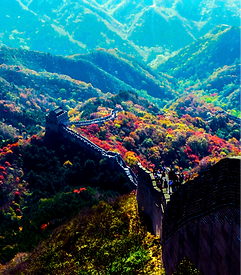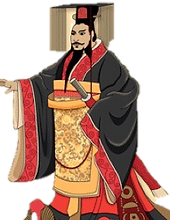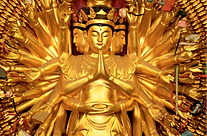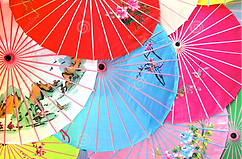
ANCIENT CHINA
Great Wall of China
On April 18 in 2009, the length of the Great Wall of Ming Dynasty (1368-1644) was announced after a full investigation. It is 8,851.8 km (5,500 miles) long from Hushan Great Wall in Liaoning and Jiayuguan Pass in Gansu. It was built, rebuilt and maintained between the 5th century and the 16th century to protect the northern borders of the Chinese Empire. The first major wall was built during the reign of the First Emperor, the main emperor of the short-lived Qin dynasty. This wall was not constructed as a single endeavor, but rather was created by the joining several walls together. There are four major walls that have been created and they are the Qin Dynasty in 208 BC, The Han Dynasty in the 1st century 1138- 1198 BC. The Five Dynasties and Ten Kingdom Period from 1368- 1620 BC. Hongwu Emporer until Wanli Emporer of the Ming Dynasty.
Qin Shi Huang crushed all the opposing states and unifield in 221 BC. The wall is complimented by fighting stations by defensive fighting stations, which wall defenders may retreat to if overwhelmed. Each tower has a unique and restricted stairways and entries to confuse attackers. Administrative centers are located at larger intervals. In addition to the usual military weapons , specialized wall defense weapons wcan be used. Reproductions of weapons are displayed at the wall. “Shoulder to shoulder, a coordinated movement of the people, their blood no longer confined in the limited circulation of the body but rolling sweetly and yet still returning through the infinite extent of China.” ― Kafka, Franz

Yangtze River
Yangtze River is the largest in river in China and the third longest in the world, Starting in Tanggula Mountain, it flows eastwards and pours itself into the East China Sea. Measuring about 6,380 km, it mainly runs across Qinghai-Tibet Plateau, Sichuan, Yunnan, Chongqing, Hubei, Hunan, Jiangxi, Anhui, Jiangsu and Shanghai from west to east. The Yangtze River Basin is a big granary of China. The grain it produces covers half of the whole nation of China, of which the rice accounts for 70% in the total. Other crops such as cotton, barley, wheat, maize and bean are also produced in the area. Besides, it is the most prosperous and densely populated area in the country. It is endowed with long history and abundant cultural relics.
The Yangtze water network covers about 1,800,000 square km accounting for 18.8% of the land area in China. The upper stream is between Yibin City in Sichuan Province and Yichang City in Hubei Province. It is also called Chuan River because most parts flows through Sichuan Province. The river in this section has many shoals and rapids. The famous scenic sight "Three Gorges" is located here. The middle stream starts from Yichang City to Jiujiang City in Jiangxi Province. Many lakes are scattered around. The section between Yidu City in Hubei Province and Chenglingji Harbor in Yueyang City in Hunan Province is called Jingjiang because it passes the ancient Jingzhou area. The down stream refers to the main river section between Jiujiang and Shanghai. The Yangtze River has numerous tributaries, merging into the river and forming a great water source to it. In 2009, another big dam the Three Gorges Dam was completed. Located near Sandouping Town in Yichang City, Hubei Province, it is the largest hydropower project, the most efficient dam in flood control and the largest migration project in the world. The two dams together produce a marked effect to the power generation, flood control, navigation and tourism in the middle and upper reaches of the river.

Terracotta Warriors
The most momentous archeological finding of the the 20th century is the Terracotta Army (Terracotta Warriors and Horses). This fascinating discovery is still an ongoing workig site. The site is found 1.5 kilometers East of Emperor Qin Shi Huang's Mausoleum in Lintong, Xian,
Shaanxi Province. If your in the area do notmiss the unbelieveable sight.
The legend goes that a young boy at the age of 13 (in 246 BC), Qin Shi Huang, next becoming the first ever Emperor in China, had begun to work for his mausleum. It took Qin 11 years to finish. It is contemplate that many treasures and sacrifical objects have been buried to chaperon the Emperor in his after life. It is told that these Warriors are patroling this
astonishing mystical land.
These pieces of pottery where found while a group of farmhands were digging a well nearby the royal tomb in 1974. This caught the eye of the archolgists immediatly. They to Xian to extend the digging of the Terracotta Warriors. Some people think that theseartifacts ae associated with Emperor Qin Dynasty (211-206 BC). The figures alter in height (183-195 cm - 6ft-6ft 5in), according to their role, the tallest being the generals. The figures include warriors, chariots, horses, officials, acrobats, strongmen, and musicians. The current estimates are that in the three craters containing the Terracotta Army there were over 8,000 soldiers, 130 chariots with 520 horses and 150 cavalry horses, the blulk of which are still buried in the trench.

Qin Shi Huang Di
Ying Zheng realized his ambition and built the first feudal and centralized empire in Chinese history in 221 BC. This was what we called - the Qin Dynasty (221 BC - 206 BC). Ying Zheng was the first emperor of a united China, so he proclaimed himself Qin Shi Huang.He was emperor for around 10 years. 220 BC until 10th September 210 BC. He became emperor because his father died when he was just thirteen, so immediately he became known to the throne. One of his main achievments in life was designing the Great Wall of China. Some of his other achivements were Establishing the Qin dynasty. Reinforcing legalism within the Chinese administrative system. Restructuring political divisions to form a more coherent state. Harmonising measurement units to allow for consistent, state-wide economic development. Standardising the different Chinese scripts. Building the Great Wall to protect the northern borders. Constructing the Lingqu canal in the south to connect the major waterways and prevent flooding. Building the overall infrastructure for national economic development. Building the impressive Terracotta Army. The terracotta warriors were made to be buried with him. One of the other great structures he built was a tomb called the Qin Mausoleum. The death of Emperor Qin Shi Huang is a big mystery. It is known that he died in 210BC in Shaqiu Palace (in today's Guangzong County, Xingtai City, Hebei Province), but no further information has been found. “The reason why China suffers bitterly from endless wars is because of the existence of feudal lords and kings.”
―Qin Shi Huangdi

chinesepictures.org
One Child Policy
At the beginning of the 1980s, the Communist party decided to introduce China’s population growth in order to stabilise food and water supplies and improve individual prosperity.In September 1980, an open letter to the country was issued by the Communist party calling for “one child per couple” rules to “keep the population below 1.2 billion at the end of the 20th century”. Women are regularly inspected to check if they are pregnant, even well into their 40s and 50s. Those who are found to be in breach can suffer forced abortions and even sterilisations. In millions of cases, families have been successful in hiding new children. The 1990 census recorded 23 million births but the 2000 census put the number of ten-year-olds at 26 million, suggesting at least three million babies had escaped the notice of family planning officials. Those who are caught can also opt to pay a “social upbringing fee”, usually a multiple of the average income in the city where the child is born, designed to cover the cost of education and healthcare. Demographers have warned the Communist party that it must take drastic action to encourage more babies or face a rapidly ageing society. By 2030, a quarter of China’s population will be over 60. China has now loosened this policy and has changed it to two children per couple. At a stroke, more than 11 million couples became eligible for a second child and officials hoped for 2 million extra births this year. Latest figures show just 700,000 couples applied for the new dispensation, and only 620,000 were given a permit. After more than three decades of the one child policy, China is now a rapidly ageing society. In just over 15 years, a quarter of its population will be over 60.

Chinese Religion
China has been one of the multi-religions since the ancient times. Confucianism is an indigenous religion and this religion is the soul of Chinese culture. This religion makes people more tolerant to others; thus, many other beliefs have been brought into this country. This is the only religion in China that was powerful enough in history to make more people spiritual. According to a latest survey, 85% of Chinese people have religious beliefs or had some religious practices and only 15% of them do not have faith in any religion. . 185 million people believe in Buddhism and 33 million have faith in Christianity and believes in the existence of God. Only 12 million people are Taoists, although more than one hundred million have taken part in Taoism activities before. Thus, it is obvious that the Buddhism has the widest influence. The other major religions are Taoism, Confucianism, Islam and Christianity.
Being brought into China 2,000 years ago, it was gradually widely accepted by most Chinese people and developed into three sections, namely the Han, Tibetan and Southern Buddhism. Buddhism not only brought a different religion, but also brought a different culture. It influences the local culture on three main aspects: literature, art and ideology. Many famous poems have ideas from Buddhism and many Buddhist stone statues can be found, which show its huge influence. It also promotes the countries’ intercultural communications with foreign communities.
Now, Buddhism has developed into the most important religion in China. The latest survey shows that 31% of the people who do not believe in this religion and have participated in some Buddhist activities and about 17 million people have already converted. Now more of those followers come from different walks of life such as the intellectuals, business elites and the common people. Recently, there is a new report, The Chinese Luxury Consumer White Paper 2012, jointly published by the Industrial Bank and Hurun Report, which shows that 39% of the intellectuals and businessmen have faith in Buddhism. Not only the number of the followers is increasing, and the education of Buddhism obtains more attention from the society. Under the Buddhist Association of China, 34 different levels of Buddhist academies can be learnt. As well as almost 50 magazines can be found. Now in Mainland China, there are about 13 thousand temples and 180 thousand monks and nuns.

Yellow River
The Chinese people call this the mother river. The Yellow River is 5,464 kilometres long and is the second largest in China after the Yangtze River. The might headwaters of this river lie in the mountain called Kunlun Mountains, North-western Qinghai Province. This long river runs through 9 provinces and autonomous regions on its way out to the Bohaj Sea. It is not exaggerating to say that this river is a melting port, because there are more than 30 branches and countless streams feeding it through its course. In in Qinghai Province to Hekouzhen in Inner Mongolia the vigorous upper reaches the river. The flow of this river is quiet, like a mouse in this section, flushing the farmlands and nurturing the people. When you reach the middle of the river you will be passing by at Taohuayu in Zhengzhou City, Henan Province. The river splits at Loess Plateau in half, forming the longest continuous gorge in the whole drainage area of the river. The lower part of the river reaches in a delta on the Bohaj Sea.
It is agreed upon by almost all the Chinese people that the Yellow River is the cradle of Chinese civilization, the spiritual home of the Chinese people.
It is the waters of the river and its spirit that nurture the whole Chinese nation. For thousands of years, this river has been admiring by literary giants, artists, as well as by the common people. The Yellow River is not just several letters, nor is it just the name of a yellow-ochre-colour river. It bears special significance: the symbol of the Chinese nation, the spirit of the Chinese people and more importantly, civilization itself.

Umbrella
Ancient Chinese people have invented so many things that we can use in our life these days. Did you realise that the ting that keep you dry when it raining the umbrella was invented in Ancient Chinese times. Something so useful by so simple .Over 3500 years ago Lu ban invented the umbrella. Lu was inspired the children in the village, using lotus leaves as rain shelter, as well as protecting themselves from the rays of sun. The useful invention was made out of flexible framework from bamboo and oil paper. They used oil paper because it repels the water. In ancient China, the umbrella was not only a day-to-day appliance, but also with sociological significance. In late Wei Dynasty, umbrella was used in official ceremonies and rites and was called the Luo Umbrella. According to Tso Chun, Jin Book • Clothing and Chariot Records, the Luo Umbrella is the symbol of rank and status as the official robe. For example, officials of the Han Dynasty above the third rank used Green Umbrella and emperors in Song dynasty used yellow and red umbrellas. Therefore, umbrellas were used in the inspection tours of emperors or senior officials in ancient times to show protection over the people. As umbrella indicates wealth and honor, it is often used in wedding ceremonies in China. Umbrella is often used in opera, song and dance, and acrobatics art as well.

History of the flag
]The most important thing that symbolise the Chinese is their flag. The flag was officially adopted on October the 1st, 1949. On this special flag there is a red background as well as 4 little stars on the right side circling 1 great star. The colour of the stars are a coloured a yellowy gold The red on the flag represents the communist revolution and its also the Chinese traditional colour. The large gold star symbolise communism, while the four smaller stars represent the social classes of the people. The five stars together reflect the importance placed on the number five in Chinese thought and history.

